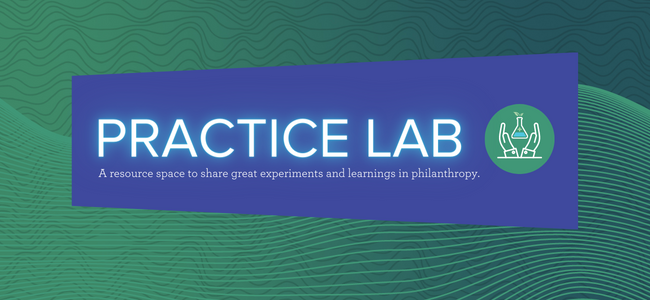Practice Lab: Partnerships in Progress

NCG's Practice Lab is a resource space to share great experiments and learnings in philanthropy. The Lab focuses on actions that experiment and take risks, fails forward with lessons learned, and lifts up equitable best practices.
Philanthropic funding doesn’t often reach the San Joaquin Valley and when it does, the level of funding doesn’t meet the need at the scale needed. Relationship building between funders and community-based organizations in the region isn’t always prioritized as it should be, leading to significant disinvestment and less effective programming from traditional philanthropy and government agencies.
In early 2023 as a part of its Climate & Disaster Resilience focus, Northern California Grantmakers (NCG) was in the midst of organizing an event for its member community spotlighting repercussions of the 2023 atmospheric river floods on vulnerable communities. Simultaneously, the University of California Merced (UC Merced) Community and Labor Center had just completed its multi-faceted Farmworker Health Study commissioned by the California State Legislature, closely examining critical issues facing farmworkers including physical health, working conditions, labor rights, the ripple effects of COVID-19 and more.
In the aftermath of the study and catastrophic flooding following 13 consecutive atmospheric rivers across the San Joaquin Valley, an idea and partnership emerged. While initially focused on providing funders with more education around farmworker health, it led to the creation of a series aimed at uplifting:
- the systemic and historic inequities of communities recovering from the storms
- the health, socio-economic, environmental, and labor challenges facing farmworkers feeding our communities
- the additional resources needed after a levee breach in Pajaro and flooding in the community of Planada
The idea eventually brought together dozens of funders, government agency staff, and community-based organizations into the Tulare Basin for a full day tour of communities impacted by the storms and decades of disinvestment.
Read more below to hear about what worked, what didn’t, and where progress and investments are shifting in the San Joaquin Valley.
How did you center the communities you are hoping to serve in your experiment?
The two-part educational series included a webinar and an in-person tour. Part 1 amplified community-based organizations’ real-time insights after the impact of the storms. We shared relevant data from the UC Merced Farmworker Health Study and Planada Community Needs Assessment, as well as other research to acknowledge the systemic and historical context surrounding the floods. The webinar served as a foundation for the second part of the series, which aimed at creating an immersive tour of communities directly impacted by the floods. The tour was an experiential journey designed to share the stories, struggles and resilience of the impacted communities.
What can you share about the process of partnership and collaboration?
The partnership expanded both networks.
UC Merced connected through Philanthropy California’s statewide network and worked with regional allies including the Latino Community Foundation, Smart Growth California, and the Irvine Foundation-all wanting to contribute to a shared mission of increasing investment in the region. UC Merced brought its subject matter expertise and a network of CBOs, workers and community members to the table, Through these community-engaged partnerships, the university both delivered on its promise as a public serving institution and offered foundations and government agencies access to rural and farmworker communities in their spaces.
NCG hoped to amplify community voices in the planning process, and UC Merced was essential to connecting us to residents and workers through their extensive networks. While the San Joaquin Valley is included in NCG’s region, staff and membership are mostly located in the San Francisco Bay and Sacramento areas. Engaging in the Tulare Basin would expand work NCG was already undertaking, but would be a relatively new endeavor for many funders. We also felt including state and federal agencies to the tour would give space for more resident voices to be heard by government officials.
What risks did you take in service of equity?
The tour presented an alternative approach to relationship building. While tours are not new to philanthropy, we hoped creating a space for shared experiences and thoughtful conversations could offer more meaningful engagement between grantees and grantors.
Providing this opportunity wasn’t a risk for us. The risk was for residents who generously let others into their communities to share their vulnerabilities and experiences with no guarantee of financial support. The tour environment gave those from philanthropy and government agencies in attendance a space to witness and engage with little pressure or risk. The community and CBOs welcomed the opportunity to engage with tour participants to forge new relationships, fortify existing ones, and generate increased interest and investments in their rural and agricultural communities.
What would you change? What lessons would you share with the field?
There are so many lessons for philanthropy from this tour that we are still unpacking, including:
- How to design respectful site visits in partnership with community
- The importance of convening funders in unfamiliar or rural regions to build long-term relationships and investments, instead of treating site visits as a “one-and-done" experience
- The unique possibilities for philanthropy in partnering with academic institutions
One major opportunity missed for NCG in the immediacy of the tour was providing an opportunity for funders to take action quickly. We brought funders on-site with CBOs but didn’t have a specific ask planned to help funders direct resources in a coordinated way towards the urgent needs that became apparent on the tour. We are working through what this might look like for the future, but certainly risk the loss of urgency the tour cemented into attendees. We also know that integrating concrete requests into the tour planning would set clearer expectations for CBOs on what may be possible after the tour and wouldn’t replicate competition between CBOs.
New trust-based funding opportunities for rural and agricultural communities could look like:
- Pooled funds dedicated to supporting worker resilience
- Multi-year cluster funds, or pilots, addressing the intersectionality of the collective work needed in the region for a holistic and integrated response
- Operational funding coupled with capacity-building initiatives
How can this idea be scaled and replicated in philanthropy?
One practical approach for philanthropy to replicate or scale engagement and investment in rural communities is to build upon the model of this educational series. Hosting an in-person visit followed by additional events or listening sessions to dive deeper into the topics that emerge may generate pathways for sustained investments.
Listening sessions in particular would serve as a valuable feedback mechanism for foundations to improve their grantmaking practices and align them with the needs of CBOs and communities, ultimately paving the way for improved collaboration.








